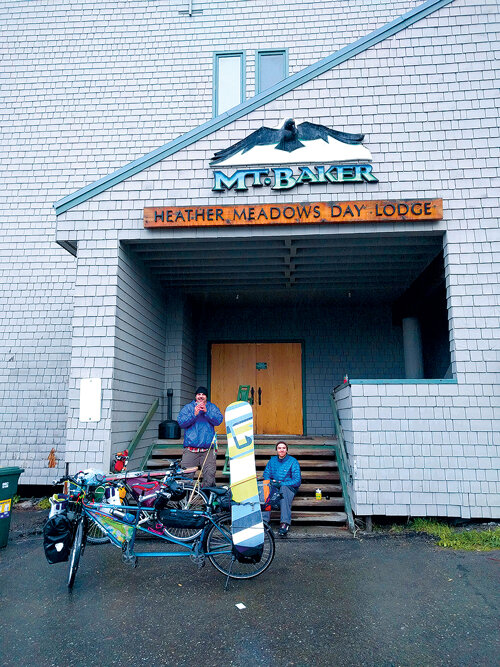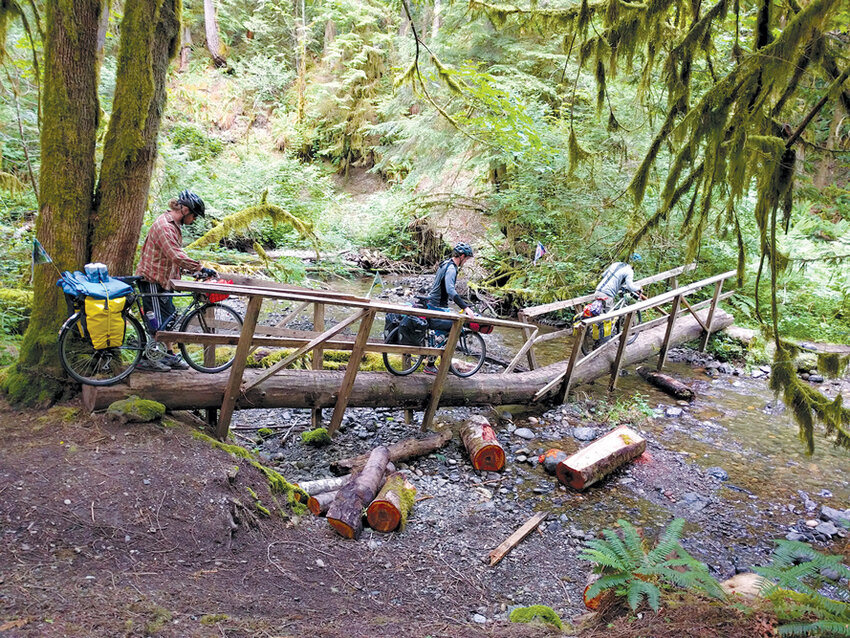Photos by Steven Gadingan
Monday, May 23, 2016
It’s 50 minutes into a planning meeting for car-free Ski to Sea and team Wetboyz of Aslan Brew have tie-dyed a bunch of uniforms, but haven’t done any actual planning. There’s a lot to work out – the Wetboyz have to get equipment and racers in place for all seven legs of the famous relay between the Mt. Baker Ski Area and Bellingham using only bicycles and brains. It’s my first time doing Ski to Sea, but the Wetboyz have done it car-free before and no one seems concerned.
Finally, someone starts a planning conversation; “How am I going to carry a snowboard on a tandem?” Travis asks. After some half-hearted suggestions about straps and panniers the discussion is cut short by a game of Ratball, the Wetboyz’ signature drinking game in which the winner gets to drink.
The Wetboyz aren’t just a Ski to Sea team. If you’ve ever been in the wrong place in Bellingham on a Monday night (Wetboyz night), you may have seen a dozen or so of the boyz, mostly on old mountain bikes, crossing a street from one section of urban trail to the next in a flurry of dinging bells and skids. Those are the Wetboyz and Ski to Sea weekend is one of their holidays.
 Wetboyz heading east through Deming. Steven Gadingan photo.
Wetboyz heading east through Deming. Steven Gadingan photo.Friday, May 27
Four days later, I pedaled east on the Mt. Baker Highway with Drew and Cale, the Wetboyz’ late crew. Five other racers and a support crew – for carrying the extra beer – had left earlier in the day and were somewhere on the highway ahead of us.
The Ski to Sea website suggests that competitors in my leg, the mountain bike leg, leave Bellingham at 9:45 a.m. on Sunday to make it to the start line in Ferndale in time. So why did we leave at 5 p.m. on Friday afternoon?
While most teams try to complete Ski to Sea quickly (it is a race, after all), car-free teams developed a tradition of taking time and turning the event into a three-day party that starts as early as Friday morning.
“It started because people down at sea level would feel left out of the party and want to go hangout,” said Kyle Morris, an architect of the first ever car-free team. “So we just added a day to it so that all those folks could go up to the mountain and we could all hang out together, because that’s the most important part.”
We were heading for the Silver Fir Campground, a perfect staging area because it’s close to the mountain legs and right by the road bike starting line.
We didn’t make it until well after midnight. We rolled to the far side of the Sno-Park and found the rest of the Wetboyz. Half of them were asleep in their tents and the rest huddled under a leaking tarp.
 Travis Meyer and Cale Wilber at Mt. Baker Ski Area. Steven Gadingan photo.
Travis Meyer and Cale Wilber at Mt. Baker Ski Area. Steven Gadingan photo.The next morning, we said goodbye to the cross-country skier, snowboarder, runner and road biker and prepared to ride down the highway to Everson. A lot of people recommend starting cold for outdoor sports. That way you won’t get too sweaty when you inevitably warm up. Bike touring in hilly terrain is especially hard to dress for, so I listened to the more experienced Wetboyz, who recommended starting wet. It would only get wetter.
Going car free
Ski to Sea added a car-free division in 2013, but people have been completing the race without cars for longer.
Morris, who founded the Hub Community Bike Shop in Bellingham, had done the race a few times before his first sans-car excursion. He often did his segment car-free, or close to it.
“I think there’s a pretty healthy handful of people who’ve always done the mountain bike leg car-free, because it’s 10 miles to Hovander,” he said. “If you can’t ride your bike 10 miles on the road… I mean, the race course is longer than the commute.”
In 2009, Morris tried to convince his friend Dominic Battistella to do Ski to Sea for his first time. Battistella replied if cars weren’t involved, he’d consider it. Morris told him cars were just part of the deal – a drawback, but a necessary one.
“And then I thought, wait, it doesn’t have to be part of the deal. What if we did it without cars? Both of us just agreed on the spot to try to figure it out,” he said.
Morris built a trailer in his weld shop out of bits and pieces of old bikes, rounded up a team and went for it.
The biggest obstacles were getting the runner to the top of the course – a problem solved with a tandem – and figuring out how to get the canoers’ bikes from the beginning of their leg in Everson to the end in Ferndale.
“I finished the bike trailer contraption two days before the race and I had a parking-lot-test’s worth of time to try it,” Morris said. “When we got to the canoe leg, I put the bikes on and just started riding it around that parking lot, which is full of potholes. By the time I got to the end of the lot I was like, I can’t do this. Who am I kidding? I’m going to die doing this.
“But then I thought, well, I can’t not do it either. I’m committed. So it worked and I figured out a bunch of things to do differently.”
That year, the first-known car-free team, the Star Speckled Banana Slugs, came in 232 out of 323 teams. Morris and company kept at it car free for a couple of years because it was just more fun than racing with cars.
“You don’t get that same sense of camaraderie when you do it with cars. You’re much more dependent on each other when you don’t have a crutch like that,” he said.
By 2010, the slugs had procreated, forming two car-free teams, and two others joined them.
 Transporting the canoers' bikes to the end of the canoe leg. Steven Gadingan photo.
Transporting the canoers' bikes to the end of the canoe leg. Steven Gadingan photo.Becoming official
Simon Graves rode with the Car Free Kiss Army in 2011 and though his canoe loaded with bikes got stuck under a logjam in the Nooksack, he was hooked. He held planning meetings at his house the next year to organize teams and get people together, and helped push the informal division into an official one.
“A lot of people wanted it to happen and I could just tell that it wouldn’t take much effort,” Graves said. “I just started an email campaign and emailed everyone persistently.”
The number of car-free teams grew nearly exponentially until 2013, when Ski to Sea’s organizers made it an official division. Eleven teams signed up that year and some nearly cracked the top 50 finishers. Car-free participation peaked in 2014 with 14 teams, and 2016 saw the most competitive car-free team yet, when Seize the Body-Float the Day crossed the line in Fairhaven 29th overall.
The division appealed to people like Graves, who were not competitive and had never done the race with a car.
“I’ve never been interested in races, but this just seemed so fun,” he said. “The actual race itself has always been something I enjoy while I’m doing it, but it’s kind of a hassle. It’s just a good excuse to do these other things and have a beginning-of-summer party.”
At first, Graves knew most of the teams who signed up. Eventually others signed up after seeing the division on the Ski to Sea website.
“One of our main goals in getting the division legitimized was to encourage more people to do it and realize it’s a possibility,” he said. “So it was really exciting when team’s started to appear that we didn’t know.”
Going car free requires a separate skillset from the rest of the race. There are many ways to handle the logistics, and some people enjoy that part more than the actual race. The Wetboyz’ ringleader and canoe hauler, Dennis Stickler, has supported the team more often than he’s raced.
On the logistics front, there’s still room for innovation, Morris said. He and Battistella once parked their canoe at the starting line in Everson, rode bikes back to Ferndale, and then ran 17.5 miles back to Everson for the start of the race. Maybe next they’ll try it on rollerblades instead of running, he said.
Graves wonders what would happen if the division became extremely competitive.“It would be interesting to see what all the winning teams would do,” Graves said. “I imagine the elite athletes being towed in trailers and not doing any of the work while being supported by a group of volunteers.”
Sunday, May 29
The day of the race, the Wetboyz came to life and crawled out of tents in a patch of woods outside Everson. I unzipped mine and found an inch of water in a shoe that I didn’t pull quite far enough under the rain fly. Once again, we
started wet.
An hour later, the crew was on the road and splitting apart. The support team and canoers went north toward the start of the river leg, while Wetboyz kayaker Dylan Drenched and I rode west toward Ferndale before splitting up to head toward the start of our separate legs.
As I rode past lines of cars trying to get to Hovander Park, I thought about all that took place in the last 100 miles: finding chalk messages pointing toward hidden party treats along the highway, rolling into camp after midnight, bombing down powerhouse hill in the pouring rain, pizza and pitchers of beer at Chair 9 in Glacier, two nights of campfires and wet camping with the car-free family.
I got to Hovander Park in Ferndale in time to let my socks dry out. There was just one detail left to take care of – my leg of the race.
 Attaching flags to bikes and other last minute preparations. Steven Gadingan photo.
Attaching flags to bikes and other last minute preparations. Steven Gadingan photo. Steven Gadingan photo.
Steven Gadingan photo. Steven Gadingan photo.
Steven Gadingan photo. Oliver Lazenby photo.
Oliver Lazenby photo.
Steven Gadingan spent five years wrenching at the Hub Community Bike Shop in Bellingham and five years shredding with the Wetboyz. Now living in Seattle, he’s Recycle & Reuse Coordinator at Bike Works.